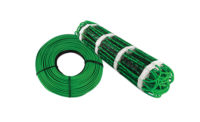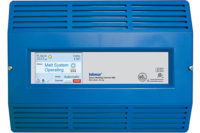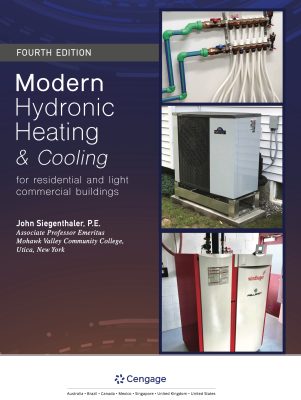Snow. It’s part of nature’s beauty — covering the earth with a pristine, white blanket and providing a universal playground for those who enjoy the thrills of skiing, sledding, snowshoeing and the like.
For commercial and institutional facilities, however, snow is a cumbersome winter guest. Building owners and facility managers are well aware of the importance of proper snow removal — from conforming to the Americans with Disabilities Act for safe and easy access, to following environmental, health and safety recommendations to providing protection from slip and fall injuries (and lawsuits).
The conventional methods to remove snow such as plowing, shoveling, salting and sanding can impose a great financial burden that continues year after year. And the cost is not just for the labor and materials associated with the removal, but also the wear and tear on the surfaces in and around the structure. Traditional snow-removal methods can even be an environmental hindrance if using special chemicals that are either tracked into the building by guests or absorbed into the ground during the spring thaw.
Another concept for snow removal that eliminates annual maintenance costs and environmental concerns has been gaining ground – literally – in the commercial sector. That technology is called hydronic radiant heat.
In a hydronic radiant snow-melting system, a warm water/glycol mixture circulates through flexible plastic tubing embedded in the ground. The crosslinked polyethylene (PEX) tubing has been used in radiant floor heating systems to heat homes and businesses in North America for more than 40 years and even longer in European countries.
Embedded hydronic snow-melting systems effectively can be used in any exterior area, including stairs, sidewalks, driveways, parking lots, parking ramps, loading docks, building entrances, wheelchair access ramps, hospital emergency entrances and even helipads on building tops. Almost any area that accumulates snow or ice can benefit from a snow-melting system.
Capitalize on the demand
With companies focusing more on environmental safety at work, as well as meeting ADA regulations, snow-melting systems are increasingly found in project specifications, making these systems a very lucrative business opportunity for wholesaler distributors serving the plumbing, hydronic/radiant and HVAC markets.
Having infrastructure or resources combing through these specifications, while also having the right product lines in place, is key to seizing this opportunity. And understanding the basic concepts of snow-melting design and installation is the logical first step.
Snow-melt system design takes into consideration several factors, including BTU per sq.-ft.-per-hr. load requirements, snowfall rates, snow density, snow temperature, outside temperature, wind speed, tubing size and tubing spacing.
There are radiant software programs available that can guide a designer through the design process, including system requirements, tubing layouts and a materials list. Some programs also can perform budget quotes, provide mechanical specifications and offer business tools to assist your contractor customer with project management.
For the system installation, an installer typically needs five basic products: radiant tubing, a heat source, manifolds, pumps and controls.
Tubing:Typically, snow-melting systems use tubing that includes an oxygen barrier. This is because oxygen can migrate through PEX walls that do not have a barrier and corrode the ferrous components, such as the boiler and pumps in a hydronic radiant system.
It is possible to use a PEX product without an oxygen barrier in a hydronic radiant application, but the system design must ensure there are no ferrous components or the ferrous components are isolated from the tubing to prevent corrosion and damage.
Another radiant tubing option called PEX-AL-PEX features an aluminum core sandwiched between two layers of PEX. This type of tubing is more rigid and can hold a bend in place. It often is used in snow-melting applications (especially on stairs) for its durability and ease of placement.
Heat sources: Heat sourcesare the methods for heating and reheating the fluid after it runs through the hydronic tubing loops in a system. For hydronic radiant systems, these can range from the traditional boiler (available in electric, condensing, cast iron and modulating-condensing) to more modern and sustainable technologies such as waste heat, geothermal and excess solar production.
In fact, a system installed in the downtown streets of Holland, Mich., uses waste heat to melt snow off the city streets, essentially providing free energy to the system. PEX tubing serves as the cooling mechanism for the turbines in Holland’s power plant. River water pumps to water-to-water heat exchangers where heat from the turbines transfers to the loops, raising water temperature to 80°F to 90°F for the snow-melting system. Two pumps circulate the water through the system and the water then returns to a nearby river at an acceptably cool temperature.
Add controls to your repertoire: When it comes to controlling the system, there are several options to choose from, including automatic, semi-automatic and manual.
• An automatic system uses a sensor placed in the ground to detect when snowfall begins. The sensor sends a signal to the heat source to activate the warm liquid flow through the radiant tubing. Once snowfall stops and the sensor is dry and clear from snow and ice, the sensor sends a signal to stop the water flow and shut down the system. This energy-efficient method of controlling a snow-melt system proves the most economical because it only runs when needed.
• A semi-automatic control requires a manual intervention to start the system, but includes a timer that will run for a preset amount of time and then shut the system off when it times out.
• A manual control is simply that. The system turns on and off with the flip of a switch.
Another option for controlling a snow-melt surface is to idle the system at a preset temperature (typically 22° to 28°) to ensure it can quickly ramp up in the event of snowfall. This option often is useful in critical areas that must remain snow- and ice-free such as walkways or entryways to buildings to keep them safe. The idle option can be used with either automatic or semiautomatic controls.
Tale of two schools
With an average winter season of 166 in. of snow (almost 14 ft.), the population of Steamboat Springs, Colo., is comfortable navigating the climate. However, thanks to a decision by the town’s school district, students at Strawberry Park and Soda Creek elementary schools now have a dry place to play during recess due to the snow-melt systems under their playgrounds.
These systems have basically the same setup as a commercial sidewalk or residential driveway snow-melt system, but with a slight variation.
“The difference is the fact it’s a playground and we have applied a layer of soft material on the concrete substrate,” says Pascal Ginesta, director of maintenance, operations and transportation for the Steamboat Springs School District. The system has its own natural gas boiler with hydronic lines that circulate through the concrete to warm it and melt the snow and ice.
The system is activated from a sensor that detects falling snow and cues the boiler. When the snow stops, the sensor sends a signal to turn the boiler off. This energy-efficient design means the system functions only during a snowfall, which never has a chance to accumulate.
When the system was first installed, a school official at Strawberry Park Elementary turned the system off during the winter break. It snowed quite a bit during that time and, with the system off, the snow accumulated and had to be shoveled away.
“That was a lesson learned,” Ginesta says. “Now the system is turned on all winter, yet it’s only activated during a snowfall.”
The system also provides peace of mind for the school district because it alleviates liability concerns associated with slips and falls on the snow and ice.
And how do the students like it? “The kids love having a dry place to play,” Ginesta says.
Jeff Wiedemann is the product manager of controls at Uponor, a provider of radiant heating and cooling, plumbing and fire safety systems for residential and commercial applications. He has more than 25 years’ experience in the hydronic radiant heating and cooling industry and is a professional member of the Radiant Professionals Alliance. He can be reached at jeff.wiedemann@uponor.com.
HELPFUL LINKS:
- Uponor
- Contact Supply House Times
- Follow Supply House Times on Twitter!
- Find Supply House Times on Facebook!










